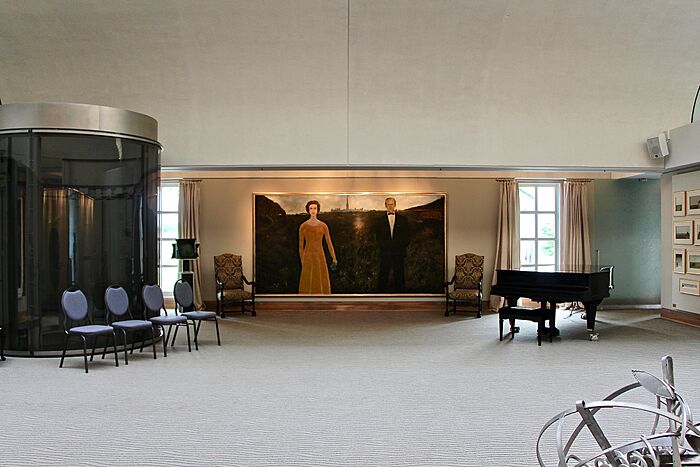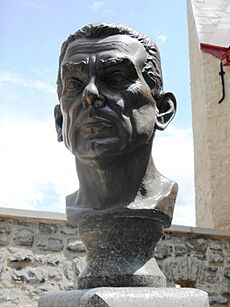Jean Paul Lemieux facts for kids
Quick facts for kids
Jean Paul Lemieux
|
|
|---|---|

Lemieux in 1977
|
|
| Born |
Marie Joseph Jean Paul Lemieux
November 18, 1904 Quebec City, Canada
|
| Died | December 7, 1990 (aged 86) Quebec City, Canada
|
| Education |
|
| Spouse(s) | Madeleine Des Rosiers |
Jean Paul Lemieux (1904 – 1990) was one of Canada's most important painters in the 20th century. He used several different styles in his art. His work is often divided into five main artistic periods.
Contents
About Jean Paul Lemieux
Jean Paul Lemieux was born in Quebec City, Canada. He also passed away there. He grew up in Quebec City until 1916. Then, his family moved to Berkeley, California. In 1917, they returned to Quebec and settled in Montreal.
Early Life and Education
As a young person, Lemieux enjoyed painting with watercolours. He took lessons in Montreal when he was a teenager. From 1926 to 1934, Jean Paul Lemieux studied art. He learned from teachers like Edwin Holgate at the Montreal School of Fine Arts.
In 1929, he traveled to Europe with his mother. While in Paris, he studied art and met other artists. Lemieux started teaching in 1934 at his old school. In 1935, he taught at the École du meuble. He moved back to Quebec City in 1937. There, he taught at the École des Beaux-Arts de Québec until he retired in 1965. He knew other famous artists during this time, like Alfred Pellan and Paul-Émile Borduas.
In 1960, some of Lemieux's paintings were shown at the Venice Biennale. This is a very important art exhibition. His art was chosen to represent Canada alongside other artists.
Awards and Honors
Jean Paul Lemieux received many awards for his amazing artwork. He won the Louis-Philippe Hébert prize in 1971. He also received the Molson Prize from the Canada Council for the Arts in 1974. In 1968, he became a Companion of the Order of Canada. This is one of Canada's highest honors. He was also a member of the Royal Canadian Academy. After he passed away, in 1997, he was made a Grand Officer of the National Order of Quebec.
Lemieux's Artistic Journey
|
Lemieux's 1979 work affectionate memory images, in the monarch's and governor general's residence at la Citadelle, in Quebec City
|
Lemieux was a representational artist. This means his paintings showed things that looked like real life. His early work sometimes looked like folk art. But in 1956, when he was 52, he changed his style. He started painting different subjects and improved his techniques.
The paintings he made after this change are some of his most famous. They often show scenes from French Canada. These scenes often include the huge, open spaces of his home country.
Famous Works
Here are some of Jean Paul Lemieux's well-known paintings:
- Marine, Baie Saint-Paul, 1935
- Notre-Dame protégeant Québec, 1941
- Portrait de l’artiste à Beauport-Est, 1943
- Le Far West, 1955
- Les Parques, 1962
- L’été de 1914, 1965
- Her Majesty Queen Elizabeth II and His Royal Highness The Duke of Edinburgh, 1979
- Dies Irae, 1982–83
The Five Artistic Periods
Experts at the Musée national des beaux-arts du Québec divide Lemieux's art career into five main periods. Each period shows a different style or focus in his work.
- Montreal period (1926–1937): In this early period, his art was very realistic. It showed natural scenes and was influenced by the Quebec region. Later, he was also inspired by European art styles.
- Primitive period (1940–1947): During this time, Lemieux focused on telling stories in his paintings. He added many small details to create a scene.
- Minimalist period (1951–1955): This period was a big change for the artist. His paintings became simpler, using shapes and structures like those found in Cubism.
- Classical period (1956–1970): This is when Lemieux created the paintings he is most famous for. He painted lonely figures in empty, stark landscapes. These works were inspired by abstract art.
- Expressionist period (after 1970): In his last period, his art showed people living in a world that seemed to be after a major disaster.
Lemieux's Legacy
Jean Paul Lemieux's art is still celebrated today. On October 22, 2004, Canada Post released a set of postage stamps. These stamps featured three of his paintings: Self-portrait (1974), June Wedding (1972), and Summer (1959). The stamps came out on the same day that a special show of his work opened. This show was held at the National Gallery of Canada to celebrate 100 years since his birth.
The Musée national des beaux-arts du Québec (MNBAQ) also held an exhibition in 2022. It was called Jean Paul Lemieux: Silence and Space.



